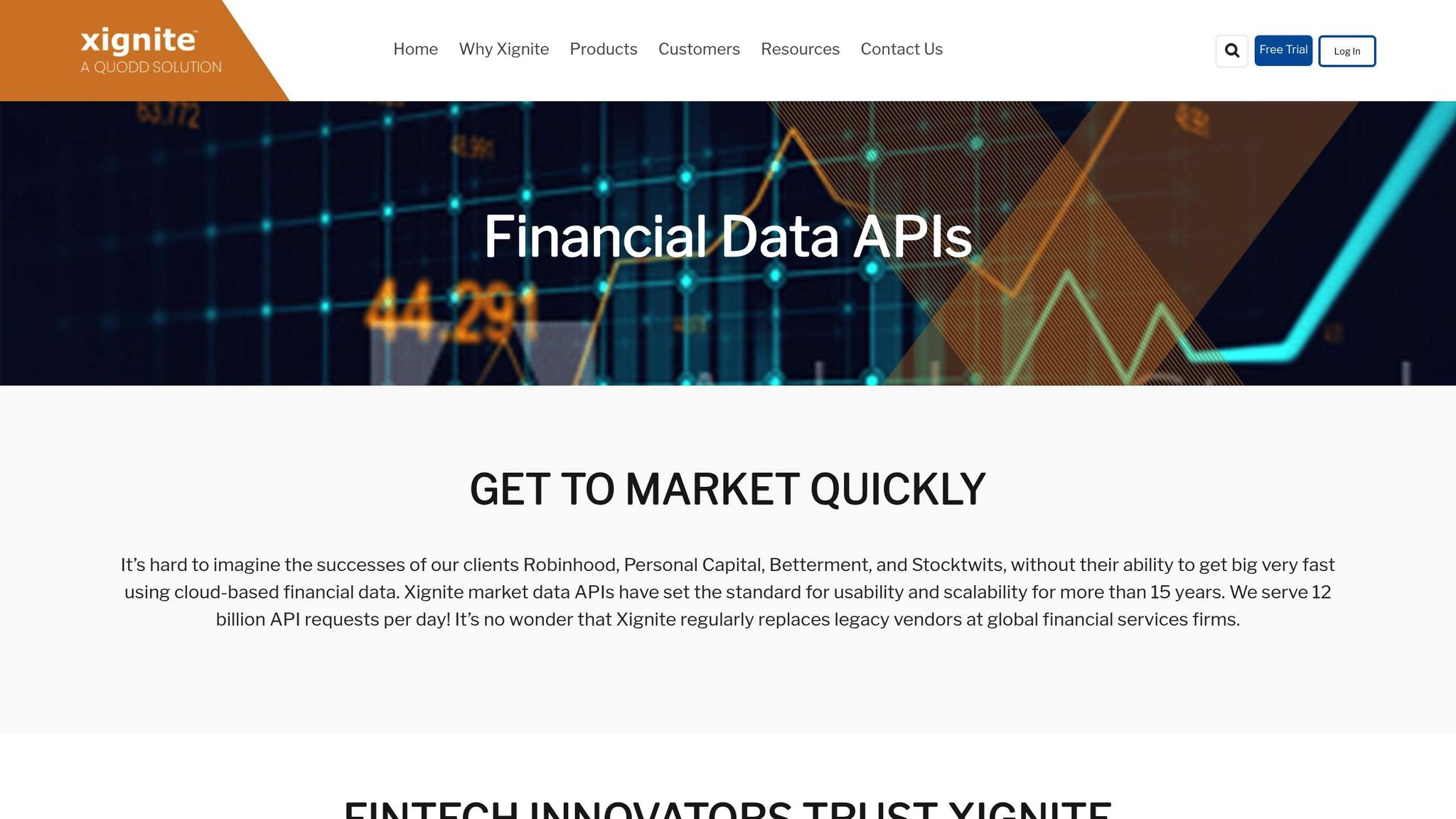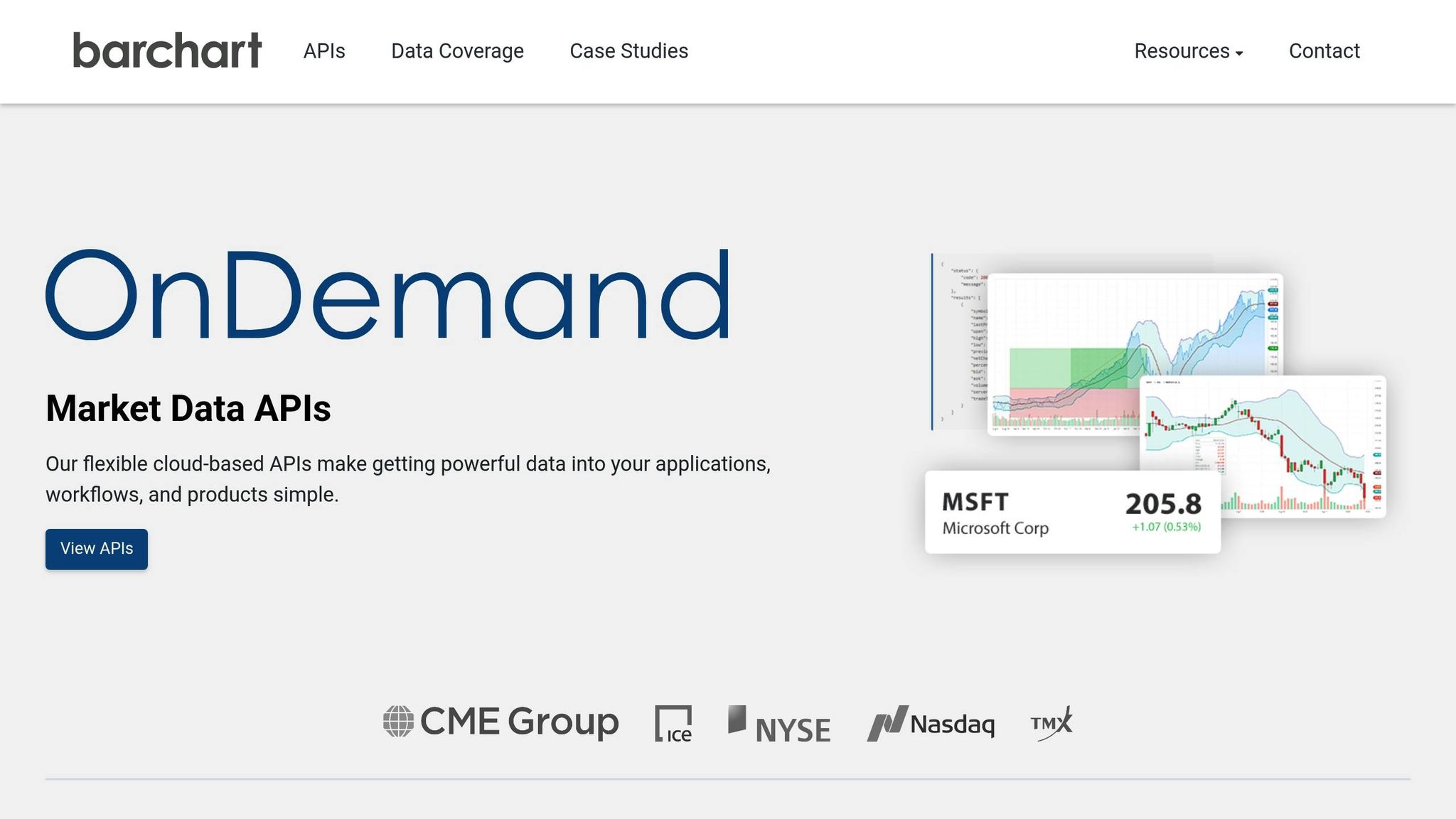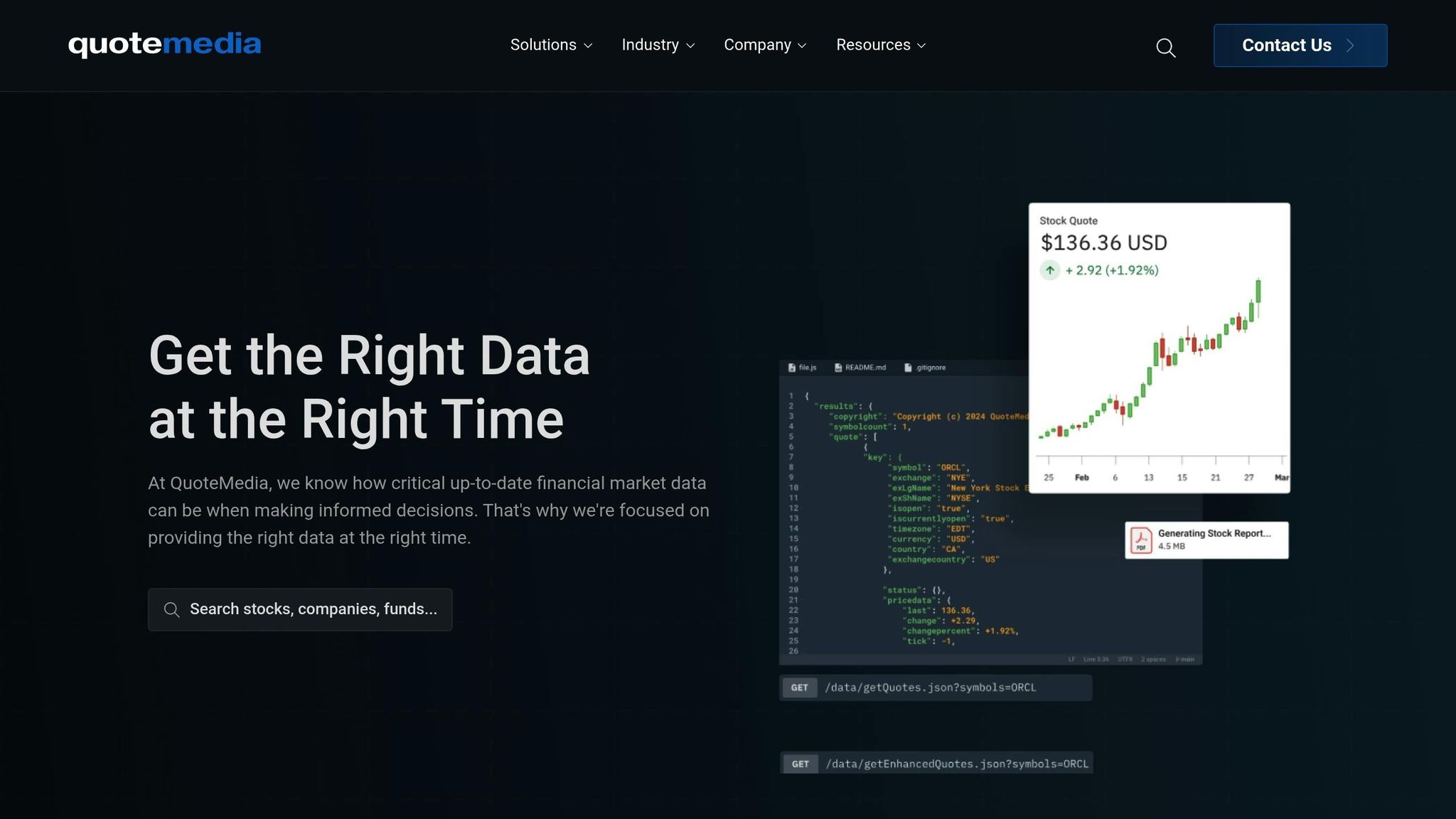Algorithmic trading thrives on speed, accuracy, and reliable data. The right trading API can make all the difference in executing profitable strategies. Here’s a quick rundown of the top stock trading APIs for 2025:
- Alpha Vantage: Affordable and beginner-friendly, offering a free tier with limited requests. Paid plans start at $29.99/month.
- Xignite (QUODD): Institutional-grade data with ultra-low latency, covering multiple asset classes. Ideal for high-frequency trading.
- Intrinio: Advanced financial data with extensive historical datasets and modular pricing for tailored needs.
- Barchart OnDemand: Pay-as-you-go pricing with strong derivatives data, perfect for futures and options traders.
- QuoteMedia: Embedded market data solutions for brokerage platforms and investor dashboards.
Each API offers distinct advantages based on latency, data coverage, pricing, and integration. Below is a quick comparison of their features.
Quick Comparison
| Feature | Alpha Vantage | Xignite (QUODD) | Intrinio | Barchart OnDemand | QuoteMedia |
|---|---|---|---|---|---|
| Asset Classes | Stocks, Forex, Crypto | Stocks, Bonds, Options, Forex | Stocks, Options, ETFs | Stocks, Futures, Options | Stocks, Options, ETFs |
| Real-Time Data | Limited Free Tier | Ultra-low latency | Enterprise-grade | Low-latency | Optimized for platforms |
| Historical Data | Extensive | Robust | 50+ years of data | Comprehensive | Bundled with news feeds |
| Pricing | Free & $29.99+/month | Premium | $3,000–$9,000/year | Usage-based | Custom pricing |
| Best For | Beginners | High-frequency traders | Institutional clients | Derivatives-focused traders | Brokerage platforms |
Choosing the right API depends on your trading strategy, budget, and technical setup. Test APIs in sandbox environments before committing to ensure they meet your needs.
Financial Engineering for Algo Trading : How to Integrate Data with Broker APIs
1. Alpha Vantage

Alpha Vantage stands out as a trusted provider in the financial data space, licensed by the NASDAQ Stock Exchange and OPRA. These licenses ensure that the platform delivers high-quality, reliable data while adhering to strict regulatory standards, making it a dependable choice for both retail and institutional investors.
Pricing Models
Alpha Vantage caters to a range of users with its flexible pricing options. The free tier allows for 5 API requests per minute and up to 500 requests daily, making it an excellent starting point for beginner algo traders. For those needing higher limits and additional features, paid plans start at $29.99 per month, offering increased rate limits and priority support.
"Alpha Vantage offers a free tier that includes 5 API requests per minute and 500 requests per day. For those who need higher limits, paid plans are available, starting at $29.99/month. This pricing makes it an affordable option for developers and traders looking to incorporate technical analysis into their algo trading systems."
Combining affordability with regulatory compliance, Alpha Vantage is a reliable option for traders who prioritize accurate and dependable data. Up next, we’ll explore another API designed to meet the demands of high-frequency trading setups.
2. Xignite (QUODD)

After being acquired by QUODD in 2024, Xignite has solidified its position as a major player in financial data services. It now supports institutional-grade algorithmic trading with a strong global infrastructure and extensive market coverage.
Data Coverage (Real-time & Historical)
Xignite–QUODD offers an impressive range of real-time and historical data across multiple asset classes, including equities, ETFs, options, futures, forex, fixed income, and mutual funds. With access to over 500 APIs, traders can create diverse algorithmic strategies without needing multiple data providers.
"Together, they offer over 500 APIs and global coverage across equities, ETFs, options, futures, forex, fixed income, mutual funds, and more." – Hackernoon
This extensive dataset integrates seamlessly with top fintech platforms, making it a go-to choice for international traders who demand reliable, enterprise-grade solutions.
Integration and Compatibility
Xignite (QUODD) is designed to work effortlessly with leading fintech platforms. Companies like Wealthfront, SoFi, and Betterment depend on its infrastructure to deliver real-time, high-quality trading data.
"Xignite/QUODD’s real strength is in powering institutional platforms – Wealthfront, SoFi, Betterment, and other fintech leaders rely on them for real-time, entitlement-controlled data delivery." – Hackernoon
One of its standout features is entitlement-controlled data delivery, ensuring traders only access the data they are authorized to use while staying compliant with regulations. For algo traders managing complex systems, Xignite (QUODD) provides the scalability and institutional-level infrastructure needed to handle high-volume automated trading – without sacrificing speed or data quality.
3. Intrinio

Intrinio specializes in providing structured financial data and valuation metrics, designed to support advanced algorithmic trading strategies.
Data Coverage (Real-time & Historical)
Intrinio offers an extensive range of data, including over 50 years of historical data for thorough backtesting. For real-time insights, it delivers equity pricing via IEX and end-of-day data for daily portfolio adjustments.
The platform standardizes financial statements from thousands of U.S. companies using 10-Q and 10-K filings. This includes detailed income statements, balance sheets, and cash flow reports. Additionally, Intrinio provides pre-calculated valuation metrics like EV/EBITDA and P/E ratios, as well as ESG scores, which are particularly useful for value-driven strategies.
Latency and Performance
With WebSocket API support, Intrinio delivers tick-level data to ensure precise market entry and exit points. Its high-performance infrastructure is reinforced by public uptime tracking, guaranteeing dependable data delivery for even the most demanding trading applications.
Integration and Compatibility
Intrinio is built for seamless integration, offering detailed documentation, SDKs, and compatibility with Snowflake for efficient data analysis. Real-time data streams via WebSocket can be effortlessly incorporated into trading algorithms, making it ideal for creating investment platforms, analytical dashboards, or custom financial models. The platform’s flexibility is further enhanced by a pricing structure tailored to specific data requirements.
Pricing Models
Intrinio employs a modular pricing approach, allowing users to pay only for the data they need. Whether it’s real-time equity pricing, comprehensive fundamental data, or options Greeks, traders can customize their packages.
Here’s a breakdown of specific pricing:
- Real-Time Stock Prices, 15-Minute Delayed SIP, and Global Real-Time Prices: $6,000/year each
- NASDAQ Basic: $9,000/year
- Real-time Options Data: $2,500/month
Overall, pricing tiers range from $3,000 to $9,000/year, with enterprise and custom packages available for more tailored solutions.
4. Barchart OnDemand

Barchart OnDemand is an API designed with developers in mind, offering a flexible, pay-as-you-go pricing model. It delivers real-time data across equities, futures, options, forex, and commodities, with a particular strength in derivatives. By combining multiple data feeds into a single solution, it simplifies integration for traders focused on derivatives-heavy strategies.
Data Coverage (Real-time & Historical)
One of the platform’s standout features is the quality of its futures and options data. This makes it a go-to choice for algorithmic traders who depend on precise derivatives data. By consolidating data across asset classes, it eliminates the hassle of juggling multiple providers.
Latency and Performance
Barchart OnDemand is built for reliability, ensuring consistent and timely data delivery. Its infrastructure handles high-volume requests with ease, making it suitable for both individual traders and institutional users. This dependable performance supports real-time trading and smooth system integration.
Integration and Compatibility
The API’s straightforward design makes it easy to integrate into existing trading systems. Using standard REST protocols, it works seamlessly with popular programming languages. As HackerNoon highlights:
"Barchart OnDemand is built for developers who value flexibility. With a usage-based model, you pay only for what you use – whether that’s equities, futures, options, forex, or commodities."
This simplicity and flexibility are particularly appealing for cost-conscious trading strategies.
Pricing Models
Barchart OnDemand operates on a usage-based pricing system, meaning you only pay for the API calls you make. This approach eliminates large upfront costs, offering better cost management and the ability to scale operations gradually.
"Broad asset coverage with a practical, pay-as-you-go pricing model."
sbb-itb-24dd98f
5. QuoteMedia

QuoteMedia is a go-to provider for embedded market data, catering primarily to brokerage platforms, investor relations (IR) portals, and financial media sites. Instead of targeting individual traders, it focuses on delivering the tools and data that power these platforms. This makes it an excellent choice for integrating market data directly into investor dashboards, brokerage applications, or custom trading systems.
Data Coverage (Real-time & Historical)
QuoteMedia combines real-time market data with historical information and market news, offering a unified stream of insights. By bundling market prices and financial news into a single feed, it simplifies data management – an essential feature for algo trading that demands uninterrupted, reliable information.
Integration and Compatibility
What sets QuoteMedia apart is its ability to provide white-label data solutions that can be easily embedded into different platforms. This flexibility ensures smooth integration into various trading interfaces. As HackerNoon highlights:
"QuoteMedia provides a suite of APIs, data feeds, and tools commonly used in brokerage platforms, investor relations (IR) portals, and financial media sites."
With APIs designed for seamless embedding, QuoteMedia is a trusted option for those needing reliable market data solutions for investor dashboards, brokerage apps, and IR platforms.
API Comparison Chart
This chart highlights the key features of various trading APIs, summarizing factors like performance, data offerings, integration options, and pricing. Use it as a quick reference to identify which API aligns with your trading needs.
| Feature | Alpha Vantage | Xignite (QUODD) | Intrinio | Barchart OnDemand | QuoteMedia |
|---|---|---|---|---|---|
| Asset Classes | Stocks, Forex, Cryptocurrencies, Commodities | Stocks, Bonds, Options, Forex, Commodities | Stocks, Options, ETFs, Mutual Funds, Forex | Stocks, Futures, Options, Forex, Commodities | Stocks, Options, ETFs, Mutual Funds |
| Real-time Data | Free tier available with limited request volumes | Ultra-low latency real-time data | Enterprise-grade real-time data | Low-latency real-time data | Optimized real-time data for embedded use |
| Historical Data | Extensive historical data across multiple classes | Robust archive of historical data | In-depth historical and fundamental data | Comprehensive historical data for backtesting | Focuses on recent data with integrated news feeds |
| Latency | Standard performance | Designed for ultra-low latency, ideal for time-sensitive strategies | Efficient for enterprise-level use | Consistently low latency | Reliable and platform-optimized |
| Integration | REST API supporting JSON and CSV | REST, WebSocket, and FIX protocols | REST API, WebSocket, and SDKs | REST and WebSocket interfaces | REST API with JavaScript widget support |
| Programming Support | Python, R, Java, C# | Python, Java, .NET, C++ | Python, R, Excel, JavaScript | Python, Java, .NET, PHP | JavaScript, PHP, Python |
| Free Tier | Free tier with limited API calls | No free tier | Limited sandbox for testing | Trial period available | No free tier |
| Pricing | Affordable for individual traders | Premium pricing for low-latency environments | Tiered pricing for institutional clients | Flexible pricing for commodity-focused users | Tailored pricing for white-label platforms |
| Best For | Beginners and researchers | High-frequency trading requiring low latency | Financial institutions and professionals | Commodity and futures traders | Seamless integration with trading platforms |
Key Considerations
While the table provides a concise overview, it’s important to note some additional distinctions:
- Performance and Latency: Some APIs are specifically designed for ultra-low latency, making them ideal for high-frequency trading strategies. Others focus more on reliable, standard performance.
- Historical Data: The depth of historical data varies. Some APIs provide extensive archives for long-term backtesting, while others emphasize recent data paired with news feeds.
- Pricing Models: Options range from budget-friendly plans for individual traders to premium solutions tailored for institutional users or specialized needs.
- Integration Complexity: Simpler REST APIs are beginner-friendly, while advanced options like WebSocket, FIX protocols, and SDKs cater to more complex systems.
Each API has its strengths and limitations, from free tier restrictions to premium costs or specialized features. Choosing the right one depends on your trading style, technical requirements, and budget.
Hardware Setup for API Performance
To get the most out of trading APIs with low latency and high performance, your hardware setup needs to be just as capable. Even the fastest API can’t deliver if your hardware struggles with data processing or order execution.
Processing Power and Memory
A top-tier processor, like the AMD Ryzen 9800X3D found in DayTradingComputers‘ Ultra system, is key for handling rapid API calls, parsing data, executing strategies, and managing orders efficiently.
Pairing this with 128GB of DDR5 RAM ensures you can store large datasets in memory, enabling faster backtesting and real-time adjustments without relying on slower storage options.
Storage and Speed
Fast NVMe SSDs significantly cut down data access times. This is crucial for analyzing historical data and logging trades quickly. A 4TB drive provides ample space, reducing the need for repeated API calls by keeping critical data local.
Network and Latency
Even the most advanced low-latency APIs can be hindered by a poor network. Research shows that up to 50% of processing time in high-performance computing is spent on data exchange over networks, making a strong, stable internet connection a non-negotiable requirement.
Multi-Monitor Setup
Using a dual-monitor setup can streamline your workflow. One screen can display API performance metrics, while the other shows live trading results, saving you time and effort by avoiding constant application switching.
VPS for Reliability
Virtual Private Servers (VPS), such as those offered by DayTradingComputers, ensure your algorithms keep running even during local hardware failures or outages. Additionally, VPS solutions located near exchange servers can further reduce latency.
Future-Proofing with Upgradable Hardware
Opt for systems that allow for upgrades, so you can scale up as your API usage and trading strategies become more demanding.
Graphics and Visualization
A high-end graphics card, like the NVIDIA GeForce RTX 4090 SUPER, is invaluable for rendering complex charts and visual data smoothly. This can speed up pattern recognition and improve decision-making.
Optimizing your hardware setup across these components is critical to unlocking the full potential of trading APIs. A solid infrastructure not only boosts execution speed and minimizes downtime but also provides the flexibility to adapt as your trading needs grow.
Conclusion
Selecting the right stock trading API is a critical step for success in algorithmic trading. Each API comes with its own set of features, so it’s important to choose one that aligns with your trading style, budget, and technical requirements.
When evaluating APIs, think about how they fit with your trading volume and strategy. Key factors to consider include latency, data coverage, pricing models, and ease of integration. These elements can significantly impact your trading performance.
It’s also worth noting that the best API won’t perform optimally without the right hardware. To fully leverage an API’s capabilities, you’ll need a high-performance system. For example, pairing an AMD Ryzen 9800X3D processor, plenty of DDR5 RAM, and fast NVMe storage with your chosen API can provide the speed and reliability needed to stay competitive in the market. This combination of advanced software and powerful hardware is essential for maintaining an edge in algorithmic trading.
Before committing any funds, take advantage of paper trading or sandbox environments offered by most API providers. These tools allow you to test the API under your specific conditions, ensuring it meets your needs without risking real capital. This trial phase is invaluable for making informed decisions that support your trading goals well into 2025 and beyond.
As the trading world continues to evolve, having the right tools in place – both software and hardware – will help you seize opportunities while minimizing technical challenges. The API you choose today plays a key role in shaping your trading success tomorrow.
FAQs
What should I look for in a stock trading API for algorithmic trading in 2025?
When choosing a stock trading API for algorithmic trading, it’s essential to prioritize data quality, low-latency performance, and broad asset coverage. These factors lay the groundwork for effective and reliable trading strategies. Another key consideration is how well the API integrates with your current tools and platforms. Smooth integration can streamline your workflow, saving you time and minimizing potential errors.
Don’t overlook the pricing structure either. Whether the API operates on a subscription model, pay-as-you-go basis, or charges extra for premium features, understanding the costs upfront is crucial. Finally, opt for APIs that support advanced AI/ML workflows. These capabilities are becoming increasingly important for building sophisticated trading algorithms as the landscape evolves in 2025.
How do the pricing plans of stock trading APIs impact my trading strategy and costs?
The cost of trading APIs plays a big role in shaping your strategy and managing expenses. Pricing often determines the level of access you get to data, the speed of execution, and the overall functionality. For instance, premium plans tend to offer perks like low-latency execution and detailed data feeds – features that are crucial for high-frequency trading. However, these come with a higher price tag. On the flip side, free or lower-cost options might restrict data frequency or introduce delays, which could hinder the performance of certain strategies.
To get the most out of your trading efforts, it’s important to weigh the API costs against your specific needs. Think about how often you require real-time data, whether minimal latency is a must for your approach, and how much you’re prepared to allocate for operational costs to meet your trading objectives.
What kind of hardware setup is recommended to maximize the performance of trading APIs for high-frequency trading?
To get the most out of trading APIs in high-frequency trading, having the right hardware setup is non-negotiable. Start with a high-performance CPU that boasts multiple cores; this ensures your system can handle the heavy lifting of complex calculations and execute trades with minimal delay. Pair this with a reliable SSD for quicker data access and low-latency RAM to keep your system running smoothly and responsively.
On the networking side, a dedicated high-speed internet connection with as little latency as possible is a must. To cut down on delays even further, consider a low-latency network card. For traders who need to shave off every millisecond, colocating servers near exchange data centers can be a game-changer.
Don’t overlook system stability – equip your setup with adequate cooling to prevent overheating and a uninterruptible power supply (UPS) to guard against power outages during critical trading moments. These steps help ensure your system is always ready when it matters most.



